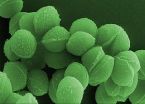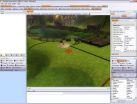Revolutionizing genome engineering
Review on history and future of the CRISPR-Cas9 system published by HZI researcher
2014-12-01
(Press-News.org) This news release is available in German.
Genome engineering with the RNA-guided CRISPR-Cas9 system in animals and plants is changing biology. It is easier to use and more efficient than other genetic engineering tools, thus it is already being applied in laboratories all over the world just a few years after its discovery. This rapid adoption and the history of the system are the core topics of a review published in the renowned journal Science. The review was written by the discoverers of the system Prof. Emmanuelle Charpentier, who works at the Helmholtz Centre for Infection Research (HZI) and is also affiliated to the Hannover Medical School and Umeå University, and Prof. Jennifer Doudna from the University of California, Berkeley, USA.
Many diseases result from a change of an individual's DNA - the letter code that genes consist of. The defined order of the letters within a gene usually codes for a protein. Proteins are the workforce of our body and responsible for almost all processes needed to keep us running. When a gene is altered, its protein product may lose its normal function and disorders can result. "Making site-specific changes to the genome therefore is an interesting approach to preventing or treating those diseases", says Prof Emmanuelle Charpentier, head of the HZI research department "Regulation in Infection Biology". Due to this, ever since the discovery of the DNA structure, researchers have been looking for a way to alternate the genetic code.
First techniques like zinc finger nucleases and synthetic nucleases called TALENs were a starting point but turned out to be expensive and difficult to handle for a beginner. "The existing technologies are dependent on proteins as address labels and customizing new proteins for any new change to introduce in the DNA is a cumbersome process", says Charpentier. In 2012, while working at Umeå University, she described what is now revolutionising genetic engineering: the CRISPR-Cas9 system.
It is based on the immune system of bacteria and archaea but is also of value in the laboratory. CRISPR is short for Clustered Regularly Interspaced Palindromic Repeats, whereas Cas simply stands for the CRISPR-associated protein. "Initially we identified a novel RNA, namely tracrRNA, associated to the CRISPR-Cas9 system, which we published in 2011 in Nature. We were excited when Krzysztof Chylinski from my laboratory subsequently confirmed a long term thinking: Cas9 is an enzyme that functions with two RNAs", says Charpentier.
Together the system has the ability to detect specific sequences of letters within the genetic code and to cut DNA at a specific point. In this process the Cas9 protein functions as the scissors and an RNA snippet as the address label ensuring that the cut happens in the right place. In collaboration with Martin Jinek and Jennifer Doudna, the system could be simplified to use it as a universal technology. Now the user would just have to replace the sequence of this RNA to target virtually any sequence in the genome.
After describing the general abilities of CRISPR-Cas9 in 2012 it was shown in early 2013 that it works as efficiently in human cells as it does in bacteria. Ever since, there has been a real hype around the topic and researchers from all over the world have suggested new areas in which the new tool can be used. The possible applications extend from developing new therapies for genetic disorders caused by gene mutations to changing the pace and course of agricultural research in the future all the way to a possible new method for fighting the AIDS virus HIV.
"The CRISPR-Cas9 system has already breached boundaries and made genetic engineering much more versatile, efficient and easy", Charpentier says. "There really does not seem to be a limit in the applications."
INFORMATION:
[Attachments] See images for this press release:

ELSE PRESS RELEASES FROM THIS DATE:
2014-12-01
Teenage boys are perhaps more known for playing computer games but girls are better at making them, a University of Sussex study has found.
Researchers in the University's Informatics department asked pupils at a secondary school to design and program their own computer game using a new visual programming language that shows pupils the computer programs they have written in plain English.
Dr Kate Howland and Dr Judith Good found that the girls in the classroom wrote more complex programs in their games than the boys and also learnt more about coding compared to the ...
2014-12-01
"We have not seen an ice free period in the Arctic Ocean for 2,6 million years. However, we may see it in our lifetime." says marine geologist Jochen Knies. In an international collaborative project, Knies has studied the historic emergence of the ice in the Arctic Ocean. The results are published in Nature Communications.
The extent of sea ice cover in Arctic was much less than it is today between four and five million years ago. The maximum winter extent did not reaching its current location until around 2.6 million years ago. This new knowledge can now be used to ...
2014-12-01
This news release is available in German. FRANKFURT The chances of patients with Philadelphia chromosome-positive leukaemia (Ph+) being cured has greatly increased in recent years. Nevertheless, a high percentage of patients have developed resistance to available medication. But now, haematologists from Frankfurt, working with a Russian pharmaceutical company, have developed a new active substance that effectively combats the most aggressive forms of Philadelphia chromosome-positive leukaemia, both in vitro and in vivo. They have reported this in the current edition ...
2014-12-01
Tropical Depression 21W crossed the Philippines and moved into the South China Sea where warm waters helped strengthen the storm into Tropical Storm Sinlaku. NASA's Aqua satellite passed over the storm and captured an image that showed it appeared elongated.
Despite the strengthening of Tropical Depression 21W into a tropical storm on Nov. 28, it appeared elongated from southwest to northeast on visible imagery taken by the Moderate Resolution Imaging Spectroradiometer (MODIS) instrument that flies aboard Aqua. The MODIS image also showed that the strongest thunderstorms ...
2014-12-01
NASA's Terra satellite passed over Tropical Cyclone 02S after it formed in the Southern Indian Ocean on Nov. 28. An image from Terra showed that the new tropical storm is close to Mauritius and Reunion Islands.
The Moderate Resolution Imaging Spectroradiometer or MODIS instrument aboard NASA's Terra satellite captured a visible image of newborn Tropical Cyclone 02S northeast of the islands of Mauritius and Reunion. The MODIS image showed that thunderstorms were mostly west of the low-level center of circulation and bands of thunderstorms were wrapping into the center. ...
2014-12-01
This news release is available in German. Humans don't like being alone, and their genes are no different. Together we are stronger, and the two versions of a gene - one from each parent - need each other. Scientists at the Max Planck Institute for Molecular Genetics in Berlin have analysed the genetic makeup of several hundred people and decoded the genetic information on the two sets of chromosomes separately. In this relatively small group alone they found millions of different gene forms. The results also show that genetic mutations do not occur randomly in the ...
2014-12-01
Two physicists from the University of Warwick have taken to the kitchen to explain the complexity surrounding what they say is one of the last big mysteries in polymer physics.
As a way of demonstrating the complicated shapes that ring-shaped polymers can adopt, the researchers have created a brand new type of ring-shaped pasta, dubbed "anelloni" (anello being the Italian word for "ring"), which they've exclusively unveiled in this month's Physics World.
With just 2 eggs and 200 g of plain flour, Davide Michieletto and Matthew S Turner have created large loops of pasta ...
2014-12-01
Peter Friedl, M.D., Ph.D., professor of genitourinary medical oncology at The University of Texas MD Anderson Cancer Center, has received one of Italy's top scientific awards for his work in imaging and cancer growth, metastasis and therapy response.
Friedl was named a recipient of the 13th annual City of Florence Prize in Molecular Sciences. Previous recipients include such scientific luminaries as AIDS research pioneer Robert C. Gallo. M.D., human genome sequencing expert J. Craig Venter, Ph.D., and Nobel laureates Robert Hubert, Ph.D. and Ada Yonath, Ph.D. Friedl received ...
2014-12-01
Replenishing the supply of a molecule that normally activates cannabinoid receptors in the brain could relieve mood and anxiety disorders and enable some people to quit using marijuana, a Vanderbilt University study suggests.
Cannabinoid receptors are normally activated by compounds in the brain called endocannabinoids, the most abundant of which is 2-AG. They also are "turned on" by the active ingredient in marijuana.
Sachin Patel, M.D., Ph.D., and his colleagues developed a genetically modified mouse with impaired ability to produce 2-AG in the brain. The mice exhibited ...
2014-12-01
This research is being carried out under the auspices of MAGDRIVE, a European research project coordinated by Professor José Luis Pérez Díaz, from the UC3M Instituto Pedro San Juan de Lastanosa, in which seven European entities participate. It consists of the development of a magnetic gear reducer, that is, a mechanism that transforms speed from an input axle to another in an output axle (as in a bicycle chain mechanism or the gearbox of an automobile). But in this case, unlike a conventional gear reducer, this transmission is produced without contact between ...
LAST 30 PRESS RELEASES:
[Press-News.org] Revolutionizing genome engineering
Review on history and future of the CRISPR-Cas9 system published by HZI researcher







